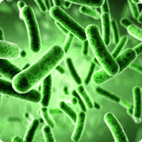 Bacteria and viruses are such small organisms that some cannot be seen under a conventional microscope. They have no taste or smell and cannot be seen by the human eye.
Bacteria and viruses are such small organisms that some cannot be seen under a conventional microscope. They have no taste or smell and cannot be seen by the human eye.
Bacteria and viruses usually enter the environment through leaking septic tanks and water runoff from feedlots, among other means. These organisms generally enter water supplies through wells that are open at the surface or those that do not have casings or caps that are watertight. Both city water supplies and private wells can become contaminated.
Harmful Bacteria Found in Water
Coliform bacteria are present in the digestive tracts of all humans and animals. While not all coliform bacteria are bad, there are some bacteria in that classification that can cause serious illnesses including intestinal infections and cholera. E. coli, the bacteria known for causing food poisoning, is also a type of bacteria that may be present in drinking water. E. coli does not live long in water and its presence is usually an indication that other harmful bacteria are present. People can and do become infected with E. coli through their water supply.
Harmful Viruses and Protozoa Found in Water
Viruses are organisms that infect people with diseases including polio, encephalitis, gastroenteritis, infectious hepatitis, and influenza. These organisms are inactive until they are ingested into a living host where they multiply and cause illness. Viruses leave the body through fecal matter that in turn contaminates water.
Symptoms of Bacterial Infections from Contaminated Water
Symptoms vary depending on the type of infection. Bacterial infections generally cause diarrhea, stomach cramps, vomiting, and fever. Virus symptoms include tiredness, fever, vomiting, headaches, muscle aches, and cramps. Chronic infections can occur when an individual continues to drink contaminated water. Symptoms can include chronic diarrhea, weight loss and even death in the young and the elderly.
Solutions
According to the Centers for Disease Control, millions of people are sickened by microorganisms in their drinking water every year. While bottled water is a feasible alternative, it may contain harmful BPA chemicals and other bacteria. The best way to ensure your drinking water is safe is to obtain a home drinking water system.



